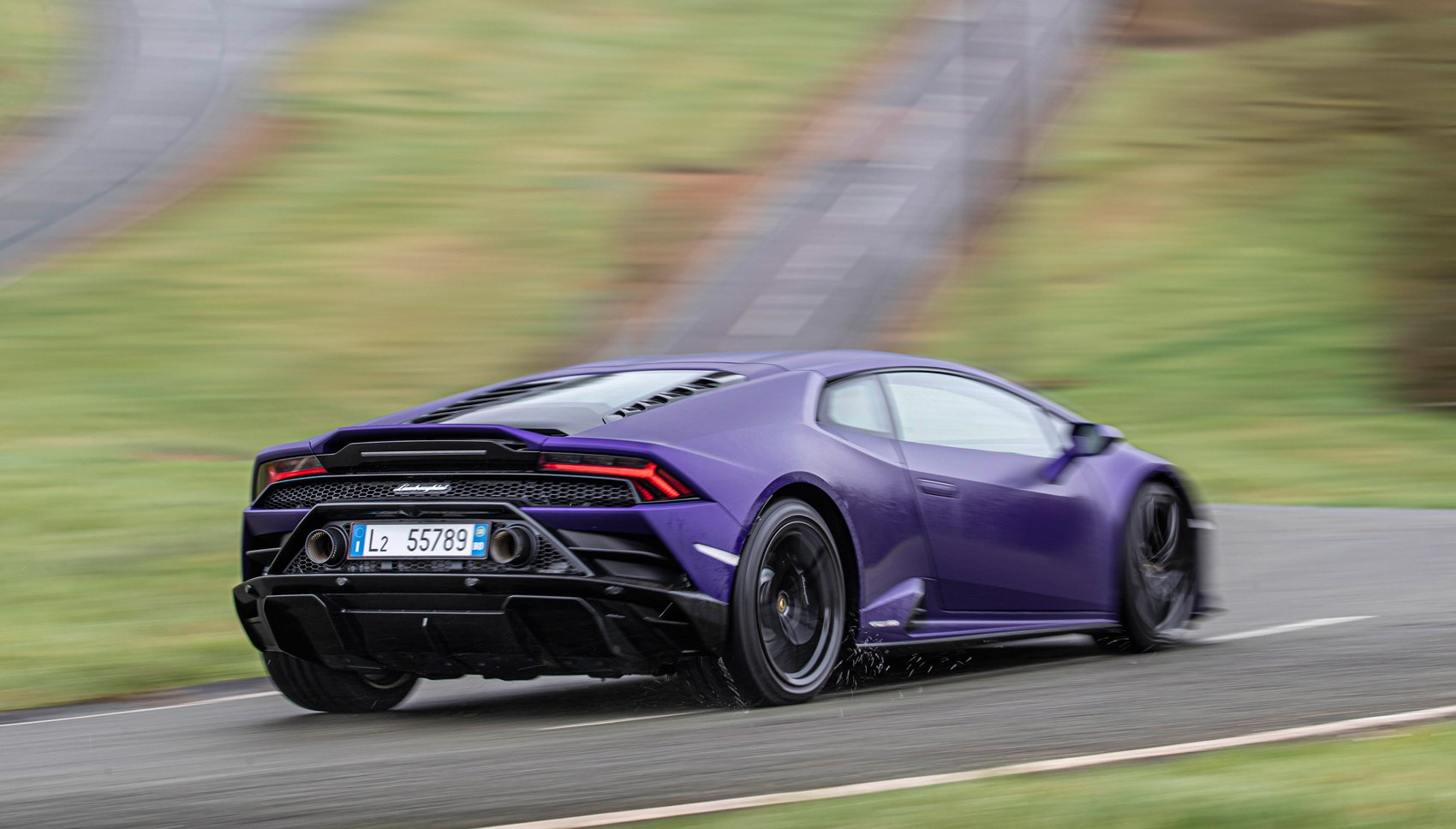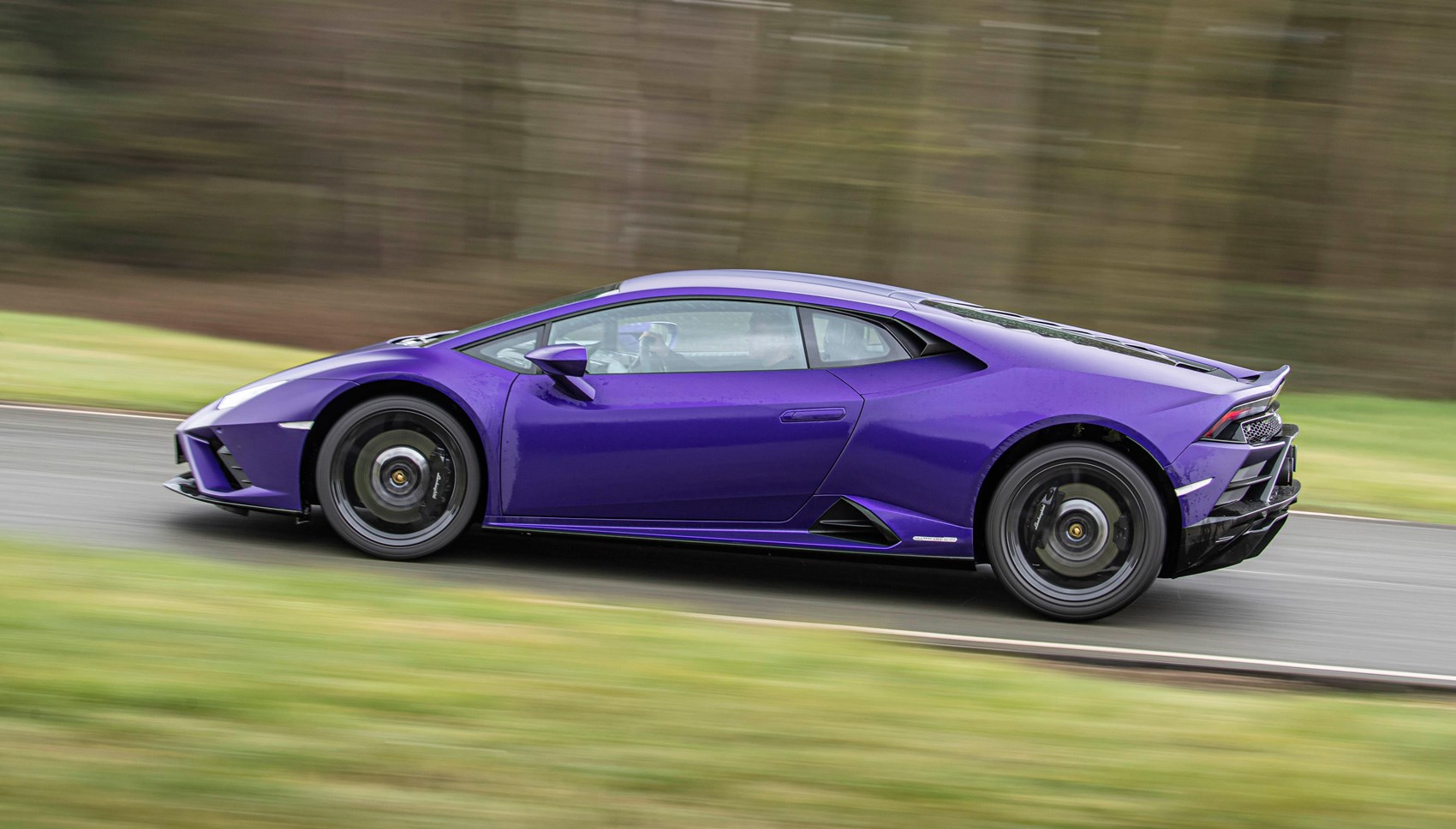► Rear-driven Huracan tested
► Purest version of V10 coupe?
► Driven on UK roads
The Huracan Evo Rear-Wheel Drive is Lamborghini’s entry-level model. Arguably, it’s also the most desirable, a car closest in spirit to its also rear-wheel-drive GT3 racecar and that even Lamborghini describes as the purest of the line.
This must have tied Lamborghini’s marketing department up in knots, but it’s something the rest of us should celebrate, given cars of this ilk are often pricier, not cheaper. Not that it’s an anomaly – the RWD follows a bloodline started in modern times by the Gallardo Balboni, and evolves the previous version of the Huracan RWD.
I’m in. What’s the spec? How affordable is it?
Well, it’s still £172,500, but that’s a huge £34k cheaper than the all-wheel-drive Huracan Evo and slots the Huracan in some fresh air against rivals – £30k more affordable than the more powerful Ferrari F8 Tributo, £20k pricier than the less powerful McLaren 570S.
The basis, of course, is the Huracan Evo, from which Lamborghini deletes the all-wheel drive and rear-wheel steering and the trick Lamborghini Dinamica Veicolo Integrata system that predictively governs the all-wheel-drive torque split, suspension, steering etc. This all contributes to a 33kg weight reduction (we’d have guessed more, though some of the stuff below explains it), and takes a larger percentage of that saving off the front axle – so the weight distribution shifts from 43/57 per cent front-to-rear, to 40/60 front-to-rear. A bonus.
There’s also some fairly significant decontenting elsewhere – adaptive dampers and Dynamic steering are now options (both fitted to our test car) as are the lightweight carbon-ceramic brakes (our test car gets heavier cast-iron stoppers); 19-inch wheels, not 20s, are standard. Externally there are tiny differences to bumpers and so on, but few will notice such small details when confronted with essentially a stealth bomber on four wheels.

Perhaps the most significant difference between the Evo RWD and other lighter/more hardcore supercars is that it’s 29bhp less powerful than the all-wheel-drive version – but still, this is a naturally aspirated 5.2-litre V10 chucking out 602bhp and revving to 8500rpm for heaven’s sake. Factor in the weight saving and it’s just 11bhp shy in the actually more important power-to-weight stakes. Nothing.
What’s it like inside?
Still totally intimidating on first acquaintance: windscreen like the tip of an arrow, limited rear visibility and when you glance in the side mirrors you see huge side air intakes as well as traffic. Our car got the optional carbon-shelled seats, wrapped in leather, which drop you down on the deck and offer good support – and actually prove perfectly comfortable on long trips, though you also feel more of the road surface, for good and bad. Obviously, it feels wide to thread about through town, and it’s a surprise to learn a Porsche 911 is no longer. At least our car’s reversing camera and nose-lift make it more useable.
How does this rear-wheel-drive version drive?
Exactly like a Lambo should – brimming with attitude, just the right side of ferocious and pretty old school in being something of a commitment to use regularly.
In the least aggressive Strada mode, the steering has a more natural, easier feel than other Huracans as you potter about, a result of the front wheels being freed from deploying power. There’s a lightness and ease to this helm that helps settle you in to the drive, and yet it’s still very nicely detailed, with even the tiniest movements off-centre making the nose jink eagerly left and right, if never nervously, at least at lower speeds. It could be more communicative still, and the speed of our Dynamic steering in tighter turns is offset by a snoozy ratio when you’ve got just a little lock applied through fast corners – the turn-in doesn’t feel as incisive as it could in those circumstances. Ramp it up to Sport and Corsa and you get more extra weight, if not any extra reward.

Strada is also all you need for the suspension, thankfully adaptive in our car’s case. Much of the time there’s actually plenty of compliance on UK roads, certainly for motorways and quick B-road work considering this is a fundamentally very firm and focussed machine, though it can come unstuck – the ride can be very tough and lumpy at low speed, there are some big thunks over expansion joints and on some particularly challenging B-roads we tested on where the damping ran out of answers and the front splitter scuffed the road surface. Both a Ferrari F8 and a McLaren 570S have more polish in this regard, but then it’s a Lambo, it’s supposed to be aggressive; fundamentally I like it. Needless to say you don’t need to flick the switch on the steering wheel for stiffer Sport or Corsa modes, and I imagine passive dampers and 20-inch wheels are best avoided. Happily, 19s still look the business.
How does it feel when you go all-guns blazing?
Lamborghini makes a big play about the stability control system being specially retuned for the Huracan and its different behaviour in different modes. Frankly it’s difficult to remember how it responded in all three modes, but I remember it still being a bit cautious if you tried to feed in the power early in Sport mode in the dry, if quite liberal if you carried excess speed in to a corner and backed off – at which point the big V10 helps the Huracan rotate really quite progressively. It’s certainly playful and adjustable in its balance.
But to properly exercise all your rear-wheel drive options, you really need to switch to Corsa mode, the only mode in which you can fully disable the stability control – which is a shame given the ride and steering effectively jump in to a pair of concrete boots. It’s then you realise just how well sorted the Huracan is – there’s limited roll over the front axle and no understeer (unless you just get it completely wrong) even when you carve hard in to a corner, at which point you can just flatten the throttle, smear black lines over the racetrack and have the V10 screaming like a Van Halen guitar solo. It’s much more fluid than an all-wheel-drive version, flowing over the surface rather than manically clawing every last scrap of grip from it.
And on the road, steel brakes offer good pedal feel and strong stopping power, though Lamborghini has long since mastered carbon-ceramic brakes – no dead-spot at the top of the pedal like there was for the Gallardo, so there’s no reason not to spec them and save the weight/improve the staying power if you can.
How about the powertrain?
A masterpiece. Turbo motors make more power and have more torque and at lower revs too, but you never miss that with this V10, which feels smooth and tractable even from very modest revs and this is still a sensationally rapid machine, even against rivals with 100bhp more. It’s quick to pick up its heels given a casual tickle of throttle, has throttle response to die for – a double treat when the rear tyres are sliding and you’re wapping out tunes on the loud pedal – and a linearity of thrust that’s only disturbed by a step at 5800rpm that warp speeds the whole thing to 8000rpm with an good ol’ days F1 soundtrack. It’ll hit 124mph from rest in 9.3 seconds. Rapid.
The usual caveats about the different driving modes apply – relatively mild-mannered in Strada, far more hairy-chested in Corsa with rolls of thunder on the downshifts, as the gear shifts progress from almost boringly seamless to something with far more mechanical punch, if not quite Gallardo violence. Like the all-wheel-drive version, you can’t tailor your own ‘Ego’ driving mode, which is a real pity – Strada steering and suspension with Sport or Corsa powertrain would be the sweet spot for the road.
Lamborghini Huracan RWD: verdict
For some, the technology and extra performance of the all-wheel-drive Huracan Evo still make it the default choice, but the cost and weight saving and above all purity of purpose of the RWD model make it my go-to Huracan. You could, of course, save even more cash and order the very similar Audi R8 RWS, but the Lamborghini’s gnarlier attitude makes it the more exciting proposition and more of an event as a supercar, even if it’s the less friendly daily driver as a consequence. Get yours on adaptive suspension with 19-inch alloys and you’ve got one hell of a supercar.
Check out more Lamborghini reviews